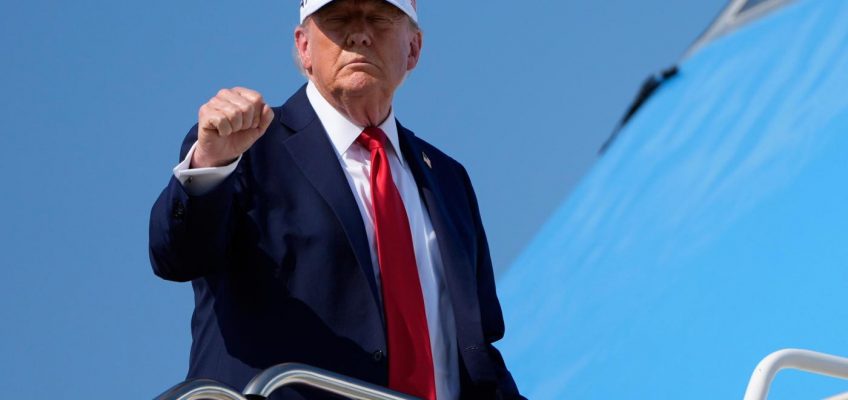Last week President Donald Trump’s Department of Justice delivered a blow to one of the foundational beliefs of the MAGA movement, one that helped carry him back to the White House.
In an unsigned memorandum, the department declared that there was no evidence that Jeffrey Epstein, the disgraced deceased convicted sexual predator, maintained a client list or that he blackmailed prominent individuals for various misdeeds. The memorandum also declared that Epstein committed suicide.
Most Americans saw this news (if they saw it at all) and barely raised an eyebrow. The Epstein story was part of the past; he died in 2019. But it detonated like a bomb in the MAGA universe. Pro-Trump influencers with vast audiences couldn’t believe what they were reading.
After all, they’d been told for years that there was an Epstein client list. Pam Bondi, Trump’s attorney general, told Fox News in February that the client list was “sitting on my desk right now to review.” (She later claimed that she was referring to the Epstein case file, not a specific client list.)
In October 2024, JD Vance, then a candidate for vice president, said, “Seriously, we need to release the Epstein list. That is an important thing.”
Before he was Trump’s director of the FBI, Kash Patel told Glenn Beck, a right-wing radio host, that the FBI had Epstein’s “black book” and that it was “under direct control of the director of the FBI.” In 2023, Patel told Benny Johnson, a MAGA podcaster, that members of Congress should “put on your big-boy pants and let us know who the pedophiles are.”
In September 2024, Dan Bongino, now the deputy director of the FBI, told his listeners, “Folks, the Epstein client list is a huge deal” that would “rock the Democrat Party.”
These quotations are a small fraction of the right-wing discourse about Epstein. During the Trump era, references to Epstein have been ubiquitous in MAGA circles. And the statement “Epstein didn’t kill himself” was so popular that it leaked out into the wider American culture.
The Epstein story mattered so much in MAGA circles because it was a key element in their indictment of America’s so-called ruling class. Trump’s appeal to the Republican base isn’t just rooted in his supporters’ extraordinary affection for the man; it’s also rooted in their almost indescribably dark view of the American government.
Why are they so keen to burn it all down? Well, if you believe your government is populated by people so depraved that they’d participate in and cover up the systematic sexual abuse of children, then you wouldn’t just want them out of office; you’d want them prosecuted, imprisoned and maybe even executed. And you’d want all the power you’d need to make that happen.
And if you believe that the ruling elites would abuse children, then they’d certainly be the kind of people who’d gin up a Russia hoax or try to steal an election in 2020. People who are that terrible are capable of anything. And if you wonder why MAGA turned on the FBI and the Department of Justice, well, it’s not just about the Russia investigation or the FBI search of Trump’s home in Mar-a-Lago. MAGA America also believed the FBI was protecting pedophiles to preserve the status quo.
On the right, the Epstein story became the thinking man’s version of the QAnon conspiracy theory — the idea that American society was led by a gang of cannibalistic pedophiles. Whereas QAnon was rooted in the imaginary revelations of a shadowy figure who claimed Q security clearance, at least the Epstein story was rooted in some very grim, very real facts.
Epstein was a monstrous and grotesque sexual predator. Along with his convicted confederate, Ghislaine Maxwell, he systematically groomed and sexually abused (and enabled the sexual abuse of) hundreds and hundreds of young women and girls.
He was also one of the most well-connected people in the world. A host of powerful people attended his parties and rode on his jet.
Oddly enough — considering MAGA’s obsession with Epstein — one of his most powerful friends was Trump. They flew together, they partied together, and in 2002, Trump told New York magazine: “I’ve known Jeff for 15 years. Terrific guy.” But Trump also made this ominous observation, “It is even said that he likes beautiful women as much as I do, and many of them are on the younger side.” After Maxwell’s arrest, Trump said: “I haven’t really been following it too much. I just wish her well, frankly.”
This was the man that MAGA trusted to fully expose Epstein and all his misdeeds?
Make no mistake: MAGA is very angry. After the Department of Justice released its memo, MAGA influencers exploded. Tucker Carlson was furious. “The whole thing that this tape shows that he didn’t kill himself is, like, a joke, but worse than that, it’s a joke that we all get,” he said. “I feel like we’re at a dangerous point now.”
Alex Jones said the Trump administration was now “part of the cover-up.” On the social platform X, Marjorie Taylor Greene wrote, “RELEASE THE EPSTEIN CLIENT LIST!!!!”
This moment is significant for another reason: It allows us to peer into the future of MAGA and see its potential crackup. After Trump is gone, this movement could tear itself apart. Its very existence is premised on a series of fantastical assertions about America and American government.
This means that MAGA influencers are constantly deceiving themselves, one another and the right-wing public. It’s an ecosystem that operates in a constant state of crisis and grievance, and MAGA supporters are so convinced that the worst possible stories are real that they’ll turn on anyone not named Donald Trump who dares to tell them the truth — or who deviates in the slightest bit from the stories they tell themselves.
Once Trump leaves office, there will be no one left to end the internal arguments and direct everyone to fall in line. If the Democrats have a problem of too many purity tests, Republicans will soon experience the consequences of putting together a coalition that may have too few. In red America, you can believe anything so long as you support Trump.
Remove that man, and only the grievances remain, and many of MAGA’s grievances are against other Republicans. The GOP coalition contains pro-vaccine and anti-vaccine factions, internationalists and isolationists, normie Republicans and wild conspiracy theorists.
Republican ideological diversity is its temporary strength. It could build a tent big enough to win very close to a majority of the popular vote. But by pulling a critical mass of disgruntled Americans into one party, Republicans have created a culture of constant conflict, and those conflicts are often rooted in completely false beliefs about American life.
Those internal conflicts are fully underway. CNN’s Kaitlan Collins reported Friday that “it’s hard to overstate the infighting” in MAGA over the Epstein case. Also on Friday, Axios reported that Bongino took the day off work after clashing with Bondi at the White House, and CNN is reporting that he’s considering resigning from the FBI. In fact, we can see a consensus hardening against Bondi: “She’s the culprit. She’s the one who pulled the bait and switch. She told us that the list was on her desk.”
Trump himself isn’t immune from attack. As part of his divorce from the MAGA movement, Elon Musk has claimed that Trump and his longtime ally Steve Bannon are in the Epstein files. “How,” Musk posted Tuesday, “can people be expected to have faith in Trump if he won’t release the Epstein files?”
By Saturday evening, Trump had enough. He posted a long screed on Truth Social that declared his support for Bondi — he said she was doing a “FANTASTIC JOB!” — and then bizarrely claimed that the Epstein files were written by “Obama, Crooked Hillary, Comey, Brennan, and the losers and criminals of the Biden administration.” In a pointed reference to Patel, he said that the FBI should be focused on investigating “Voter Fraud, Political Corruption, ActBlue, the Rigged and Stolen Election of 2020, and arresting thugs and criminals,” rather than “spending month after month looking at nothing but the same old Radical Left inspired Documents on Jeffrey Epstein.”
Judging from the early response online, MAGA is not satisfied. The usually faithful Benny Johnson was shaken. “By admitting that the Epstein Files are real,” he said, “and that you’ve read them, and you don’t like their contents, and they were written by your enemies, it doesn’t make the most compelling case as far as I’m concerned. Holy moly.”
Related Articles
Trump to make unprecedented second state visit to UK in September
Tariffs on Brazil Could Leave Coffee Drinkers With a Headache
Drones Are Key to Winning Wars Now. The U.S. Makes Hardly Any.
Trump says he’s considering ‘taking away’ Rosie O’Donnell’s US citizenship
Workplace mental health at risk as key federal agency faces cuts
The Epstein case remains a bit of a black box to most Americans. We still don’t know all the details of Epstein’s relationships with the rich and powerful, and in the absence of knowledge, wild allegations spread unhindered by hard facts.
This much we do know: Some of MAGA’s most trusted voices — including Patel, Bondi, Bongino and Trump himself — are suddenly telling their movement: Move along, there’s nothing to see here. But MAGA does not want to hear what they have to say.
This article originally appeared in The New York Times.




